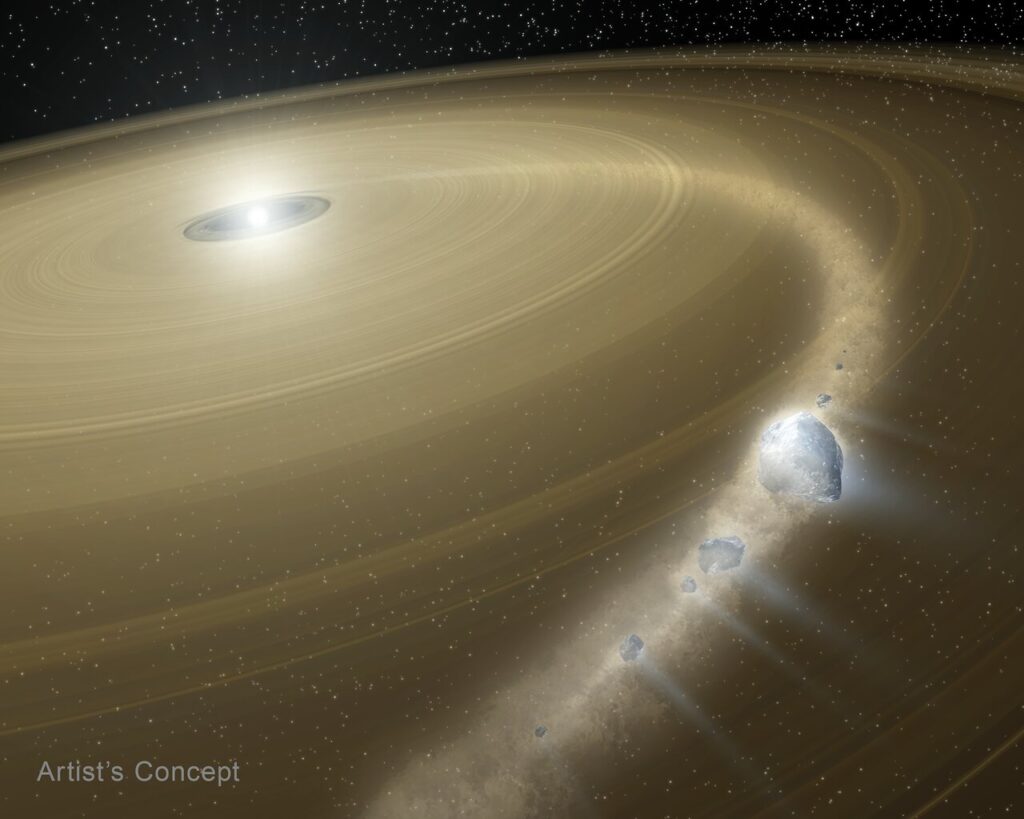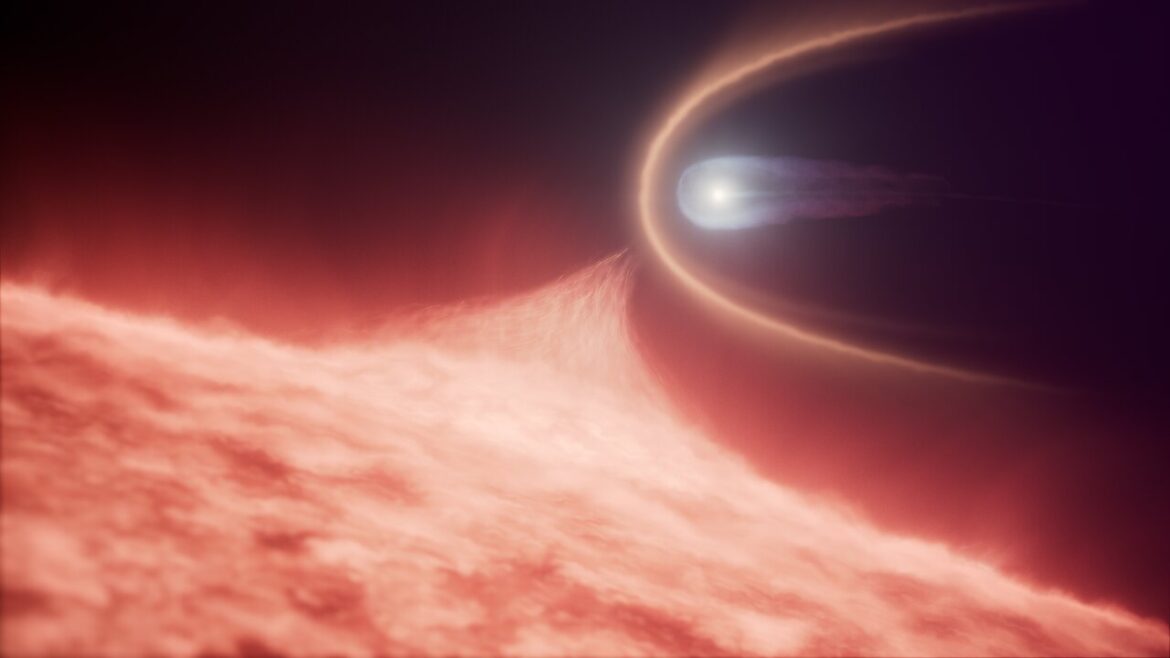Hubble sees white dwarf eating piece of Pluto-like object: a new study reports the accretion of an icy extrasolar planetesimal on to WD 1647+375
In our nearby stellar neighbourhood, a burned-out star is snacking on a fragment of a Pluto-like object. With its unique ultraviolet capability, only the NASA/ESA Hubble Space Telescope could identify that this meal is taking place.
The stellar remnant is a white dwarf about half the mass of our Sun, but that is densely packed into a body about the size of Earth. Scientists think the dwarf’s immense gravity pulled in and tore apart an icy Pluto analogue from the system’s own version of the Kuiper Belt, an icy ring of debris that encircles our Solar System. The findings were reported on 18 September 2025 in the Monthly Notices of the Royal Astronomical Society.
An international team of astronomers were able to determine this carnage by analysing the chemical composition of the doomed object as its pieces fell onto the white dwarf. In particular, they detected “volatiles” (substances with low boiling points) including carbon, sulphur, nitrogen, and a high oxygen content that suggests the strong presence of water.
“We were surprised,” said Snehalata Sahu of the University of Warwick in the United Kingdom. Sahu led the data analysis of a Hubble survey of white dwarfs. “We did not expect to find water or other icy content. This is because the comets and Kuiper Belt-like objects are thrown out of their planetary systems early, as their stars evolve into white dwarfs. But here, we are detecting this very volatile-rich material. This is surprising for astronomers studying white dwarfs as well as exoplanets, planets outside our Solar System.”
Only with Hubble
Using Hubble’s Cosmic Origins Spectrograph, the team found that the fragments were composed of nearly two thirds water ice. The fact that they detected so much ice meant that the pieces were part of a very massive object that formed far out in the star system’s icy Kuiper Belt analogue. Using Hubble data, scientists calculated that the object was bigger than typical comets and may be a fragment of an exo-Pluto.
They also detected a large fraction of nitrogen – the highest ever detected in white dwarf debris systems.
“We know that Pluto’s surface is covered with nitrogen ices,” said Sahu. “We think that the white dwarf accreted fragments of the crust and mantle of a dwarf planet.”
Accretion of these volatile-rich objects by white dwarfs is very difficult to detect in visible light. These volatile elements can only be detected with Hubble’s unique ultraviolet light sensitivity. In optical light, the white dwarf would appear ordinary.
About 260 light-years away, the white dwarf is a relatively close cosmic neighbor. In the past, when it was a Sun-like star, it would have been expected to host planets and an analogue to our Kuiper Belt.
Like seeing our Sun in the future
Billions of years from now, when our Sun burns out and collapses to a white dwarf, Kuiper Belt objects will be pulled in by the stellar remnant’s immense gravity.
“These planetesimals will then be disrupted and accreted,” said Sahu. “If an alien observer looks into our Solar System in the far future, they might see the same kind of remains we see today around this white dwarf.”
The team hopes to use the NASA/ESA/CSA James Webb Space Telescope to detect molecular features of volatiles such as water vapour and carbonates by observing this white dwarf in infrared light. By further studying white dwarfs, scientists can better understand the frequency and composition of these volatile-rich accretion events.
Sahu is also following the recent discovery of the interstellar comet 3I/ATLAS. She is eager to learn its chemical composition, especially its fraction of water.
“These types of studies will help us learn more about planet formation. They can also help us understand how water is delivered to rocky planets,” said Sahu.
Boris Gänsicke, of the University of Warwick and a visitor at Spain’s Instituto de Astrofisica de Canarias, was the principal investigator of the Hubble program that led to this discovery.
“We observed over 500 white dwarfs with Hubble. We’ve already learned so much about the building blocks and fragments of planets, but I’ve been absolutely thrilled that we now identified a system that resembles the objects in the frigid outer edges of our solar system,” said Gänsicke. “Measuring the composition of an exo-Pluto is an important contribution toward our understanding of the formation and evolution of these bodies.”

Credit: T. Pyle (Caltech, NASA’s Jet Propulsion Laboratory)
Bibliographic information:
Snehalata Sahu, Boris T Gänsicke, Jamie T Williams, Detlev G Koester, Jay Farihi, Steven J Desch, Nicola Pietro Gentile Fusillo, Dimitri Veras, Sean N Raymond, Maria Teresa Belmonte, Discovery of an icy and nitrogen-rich extrasolar planetesimal, Monthly Notices of the Royal Astronomical Society, Volume 543, Issue 1, October 2025, Pages 223–232, https://doi.org/10.1093/mnras/staf1424
Press release from ESA Hubble











